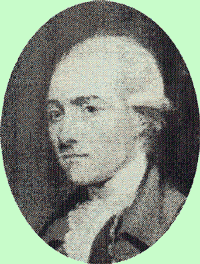

Dr. William Brownrigg, a great and respected 18th century scientist, can be regarded as one of Whitehaven's own even though he wasn't born here. This is because his medical practice was based in Whitehaven and the observations he made, that brought him renown and a distinguished place as a Fellow of the Royal Society, were made at his laboratory here.
William Brownrigg was born at High Close Hall on the 24th March 1711 and was the son of George and Mary Brownrigg. He was educated locally and started private tuition in Greek and Latin from the Vicar of Bridekirk at the age of 13. Two years later he became apprentice to John Atkinson, a surgeon/apothecary, at Carlisle and continued studying his classical languages with the addition of French plus Geometry and Mathematics.
William commenced his medical studies in London for two years with the surgeon, Mr. Barnwilt, before he started at the famous Dutch University of Leiden. There he studied for several years under such luminaries as Boerhaave the founder of modern clinical teaching, s'Gravesande, the physicist, von Royen, the botanist, and Bernhard Siegfried Albinus the celebrated anatomist. Brownrigg produced his dissertation De Praxi Medica Ineunda ... a discussion on how air, climate and environment relates to medical practice and was awarded his doctorate in medicine in 1737.
Almost immediately on returning to England he took up medical practice in Whitehaven under Richard Senhouse, an established Doctor and Leiden graduate, who died within months leaving a distinguished client list to Brownrigg. He rented a house at 24 Queen Street and continued his practice in Whitehaven for 30 years, although he also treated the Curwens and Christians and people as far away as Carlisle.
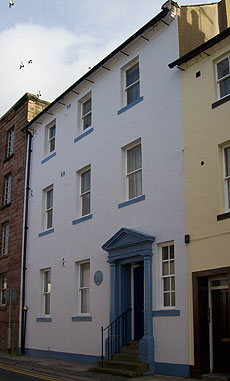
William Brownrigg's house in Whitehaven
His casebook survives. Extracts were recently transcribed by Joan Yell and Jean Ward from the original Latin and published. The cures he used were various unctions, tablets and herbal tonics, unique for each patient and derived from a curious mix of science and folklore. Obvious ingredients included laudanum, opium and quinine and many household items such as vinegar, turpentine, castor oil and sugar. He used herbal extracts such as spirits of wild chamomile, rhubarb, cinnamon water, juniper oil, fennel root and sea holly root. But there were also some more esoteric components such as powdered millipede, rabbits blood, wormwood, pure nitre and diascordium.
In 1741 he married Mary Spedding daughter of John Spedding who was one of Lord Lowther's colliery agents. He thus became interested in the health of the miners and wondered how the gases found down mines might affect them. A tragic explosion at Corporal Pit in 1737 had claimed the lives of 21 men and 1 woman. Brownrigg treated burn victims with warm salad oil but prevention was obviously better than cure. Carlisle Spedding, the great engineer who also experimented on gases and invented the Spedding steel wheel, a form of safety lighting, became a natural ally. With Lowther's permission William Brownrigg constructed a laboratory - described as a small hut - near Corporal pit. Carlisle Spedding then fed through lead pipes a supply of fire damp (methane) into the lab which fed a number of furnaces with the capability to produce the most gentle or intense heat - over a hundred years before the invention of the Bunsen burner.
As part of his investigations into the mine gases, William Brownrigg had been measuring the barometric pressure in the mine. A fatal explosion in the pit alerted him to the fact that it had been preceded by a fall in pressure a fact he could use to predict explosions and thus give warnings.
In 1757-8 an outbreak of jail fever (typhus) broke out in Whitehaven and was so severe that although it started out taking only 1 in 10 of its victims the death rate increased to 50% of those infected. Brownrigg became interested in epidemiology and in 1771, when Britain faced another plague outbreak from Europe, published a paper "Considerations on the means of preventing the communication of pestilential contagion, and of Eradicating it in Infected Places"
Spedding was one of the first to use steam engines in mining. Brownrigg investigated ways
that they might be made more efficient. He looked at agitating the water in the main
boiler mechanically or with steam and superheating the steam by passing the pipe to the
cylinder through another furnace or the flue of the main furnace. As the engines of the
time couldn't take any more pressure he thought these methods only capable of increasing
their efficiency.
Scientific understanding of gases was at such an early stage that English chemists referred to them as airs or in Brownrigg's case damps - the expression used in the mines. Brownrigg developed a method of collecting and transferring gas from one vessel to another. Sir James Lowther, who was also interested in science, had taken some bladders of mine gas prepared by Brownrigg to show The Royal Society of which he was a member. On his recommendations, and payment of the 25 guineas fee, William Brownrigg was also made a life member. He published a paper on his investigations into the composition of mineral waters which won the Copely Medal, the ultimate accolade of scientific achievement awarded annually by the Royal Society.
Brownrigg was always reluctant to leave Cumberland and so his papers were usually read out by others and much of his scientific thinking put forward in correspondence to other scientists - something which his friend and biographer Dr. Joshua Dixon felt was sometimes taken to advantage by others gaining acclaim for his research. In fact when Priestley was presented with a gold medal from the Royal Society for investigations into air the President indicated the too modest Brownrigg had done the foundation work.
In 1774 he studied 20 different salts collected from the mines at Whitehaven and presented his findings in another paper to the Royal Society along with the samples which were placed in the British Museum. He also collected and studied the minerals around Keswick but his findings were never published.
In 1748 Brownrigg wrote a book about making salt with the snappy title of "The Art of Making Common Salt as Now Practised in Most Parts of the World with Several Improvements Proposed in that Art for the Use of the British Dominions" which ran to nearly 300 pages, much of which was footnotes.
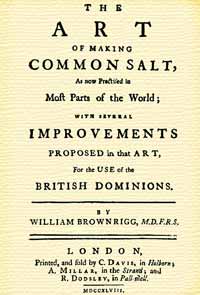
Britain's salt was of such poor quality that Brownrigg thought that when used as a preservative it might actually speed up the decay of meat and fish. France and Holland both produced better salt but European wars meant British supplies became expensive. The government had offered 10,000 shillings for improved domestic manufacture and the recipient, Mr. Lowndes, published a document that Brownrigg thought fell short of the mark. With a patriotric and philanthropic spirit William Brownrigg collected together all the information he knew on the subject and used his scientific mind to propose improvements.
He also felt his methods could be applied in North America and thus reduce its dependence on supplies from the Caribbean which had been disrupted by the Spanish. In fact his treatise was delivered to James Bowdoin of Boston by Benjamin Franklin in 1753.
He thought salt could also improve the fisheries for Western Scotland and by improving their lives possibly reduce the chance of insurrection as had happened with the '45 Jacobite rebellion.
Brownrigg had insight into the secret Dutch method of production from his time in Holland and also laid out the French method of evaporating sea salt. Observing the rates of evaporation in England verses precipitation he calculated their effects for English salt pans. From this and his knowledge of domestic production at Whitehaven and other places he proposed better forms of manufacture which he felt would allow British production to satisfy its domestic requirements, and improve the nation's wealth. An abridged version was included in the Royal Society transactions.
Platinum, now known by virtually everyone as a metal more rare and valuable than gold, was virtually unknown in the 18th century until William Brownrigg presented it to the Royal Society. Charles Wood, Brownrigg's brother-in-law had come across the metal in Jamaica. It had been mined in Central America but ironically because it was being alloyed and passed off as gold the Spanish had stopped its production. Realising it had unique properties, Wood did some experiments and brought back samples to Brownrigg who wrote up the experiments and started to do a series of experiments himself. In one experiment he heated it in one of his furnaces for two hours - unlike iron it didn't melt. He passed a draft paper and the four samples to the Royal Society in 1750 encouraging further study saying :-
"it may be endowed with some peculiar Qualities, that may render it of singular Use and Importance to Mankind".
The samples were:- 1. platinum ore 2. purified platinum 3.fused platinum 4. part of a sword pummel. His findings were that it had the fixity of gold, the hardness of iron, cannot be acted on by acids and not injured by water or air. One of the experiments he did was cupellation, an assaying technique, and found that it didn't resist lead as previously thought. He explained this in another letter to the Royal Society the following year in which he also noted its similarities to gold.
In 1771 the great American politician and scientist Benjamin Franklin was on a tour of Britian accompanied by the scientist Sir John Pringle who arranged a visit see William Brownrigg in Cumberland who being informed of their interest wrote to Franklin on June 12th to invite them to stay. Franklin already had a copy of Brownriggs book on Salt which he had recommended for improving American fisheries and had also purchased for the Philadelphia library.
Franklin seemed to have enjoyed his stay at Ormathwaite and demonstrated his party trick by adding some oil he kept in a small vessel in his walking stick to the waters of Dewentwater which had a calming effect on the waves. Brownrigg later wrote to Franklin with some information on the subject and Franklin replied to Brownrigg explaining all he knew on the subject and his belief that some sort of mutual repulsion between the oil and water was responsible for the way it spread so quickly across the surface. He also commented on Mary Brownrigg's attempt to make Parmesan cheese describing her as a philosophess. Brownrigg wrote a piece for the transactions in 1774 entitled "On the stilling of waves by means of oil"
William Brownrigg seems to have then taken Benjamin Franklin to Whitehaven for a trip down a coal mine that Franklin refers to in later letters.
In 1765 William Brownrigg became a partner of another Whitehaven man, Anthony Bacon, in a venture that played a major part in development of the Welsh Iron Industry. The idea was to build a furnace at Merthyr Tydfil to exploit Welsh coal, water and iron to manufacture canons for the government. The fact that Anthony Bacon had learnt to trade as a Master Mariner and had developed government contracts would suggest he was the money making businessman behind the scheme - whilst Brownrigg's study of mining and his connections with Lowther and the Speddings and Charles Wood suggest he was the brains of the operation. In fact Charles Wood became heavily involved as the metallurgist and much of the Iron Ore was supplied from West Cumbria when Welsh supplies failed to keep up with demand. The Cyfarthfa ironworks eventually became the largest iron producers in the world. Brownrigg finished his side of the partnership in 1777 as he retired from business to spend his final years at Ormathwaite the home he had inherited on his father's death in 1760.
He had also leased a large area of Skiddaw forrest as a business venture and inherited a share of his father-in-law's ropery. Another investment was in the Keswick Turnpike Trust. Either his business acumen wasn't as great as his scientific, or his failing mental state was taken advantage of in his final years, or perhaps he was too generous - for he died in debt to the sum of £8000.
During his retirement he was also writing a history of Cumberland and encouraged Father Thomas to write his celebrated Guide to the Lakes in 1778 laying out the basic plan for the book. This was the first Lake District guide for tourists.
He had also become a polital agent for James Lowther, patent searcher at Port Carlisle and the receiver General of Governemt taxes for Cumberland and Westmorland. He served as a magistrate and also spent time at Ormathwaite developing agriculture in the area by improving drainage and fertility of the soil. Some of his leisure time was spent reading classical poetry and collecting art.
Brownrigg became a vice-president of the Whitehaven Dispensary from its inauguration in 1783, and contributed two guineas annually for the rest of his life and its principal physician Dr. Joshua Dixon became a friend and biographer.
His death on the 6th January 1800 brought the following short obituary in the Cumberland Paquet:-
"Yesterday se'ennight,(the 6th inst) at Ormthwaite, near Keswick, William Borwnrigg, M.D.F.R.S. of London and Edinburgh, aged 88 years. This venerable Philosopher and Physician was possessed of every excellent quality which could adorn the great and good. He was one of the first who improved the Doctrine of Factitious Airs; and his judicious experiments upon the Pyrmont Spa Water led, afterwards to those enquiries which have, of late years, so much enlightened Philosophy."
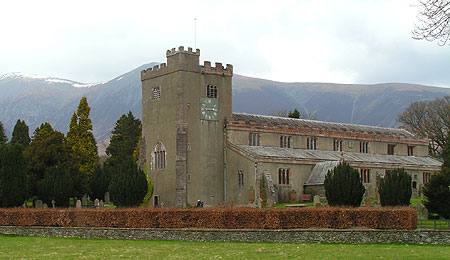
Crossthwaite Church at Keswick with Skiddaw in the distance
Short praise for such an eminent man who had worked all his life to improve humanity but the pall bearers at his funeral at Crosthwaite church, near Keswick, a week later indicated the level of respect he had achieved within his lifetime.
Sir Wilfred Lawson Bart. Andrew Huddleston Esq.
Sir Michael Fleming Bart Thomas Wallace Esq.
Sir Fredrick F. Vane Bart
Dr. Joshua
Dixon
Rev. Wilfred Huddleston William
Brown Esq.
Rev. Charles Cobbe Church Mr Samuel Potter
Thomas Storey, Esq. Mr Peter
How Younger
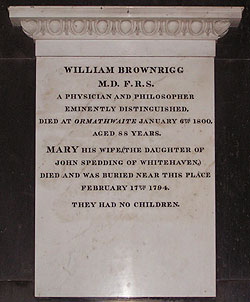
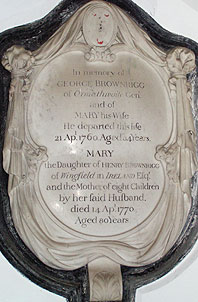
Memorial to William Brownrigg in Crossthwaite church at Keswick and that of his father, George Brownrigg
One feels that had Brownrigg been more narrow minded and dedicated his study to one field he could have been a great scientific discoverer. Had he been a self-publicist and mixed socially with other great figures of the day in London he might be remembered as one of the 18th century's greatest figures. As it was he dedicated his life to others, achieved a lot, was respected by everyone that knew him and almost faded into obscurity - a quiet country doctor.
ref: William Brownrigg biography by Joshua Dixon
Cumberland Paquet 1800
Whitehaven - Daniel Hay
Letters of Benjamin Franklin
Platinum Metals review 1961
© WAWL 2008